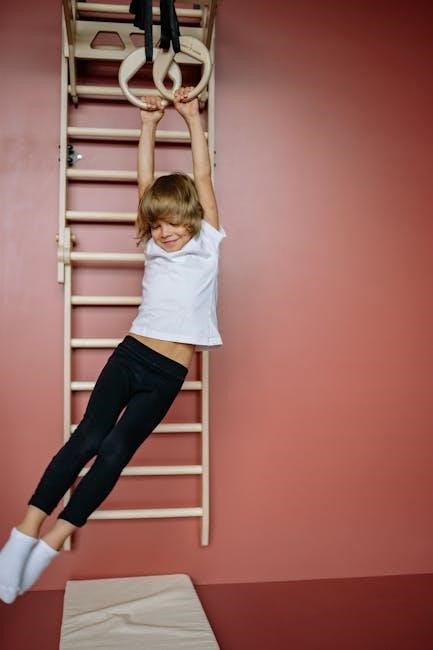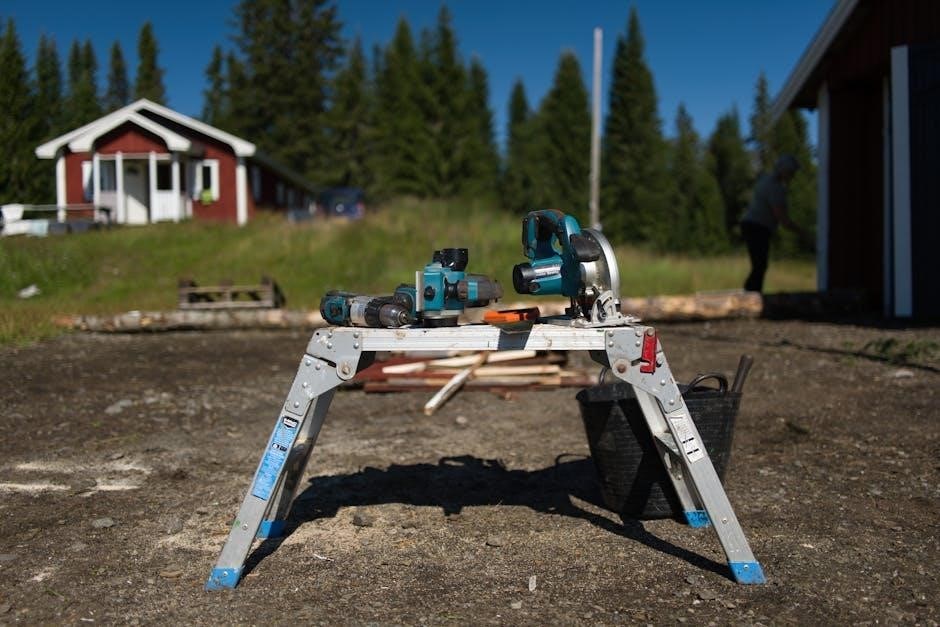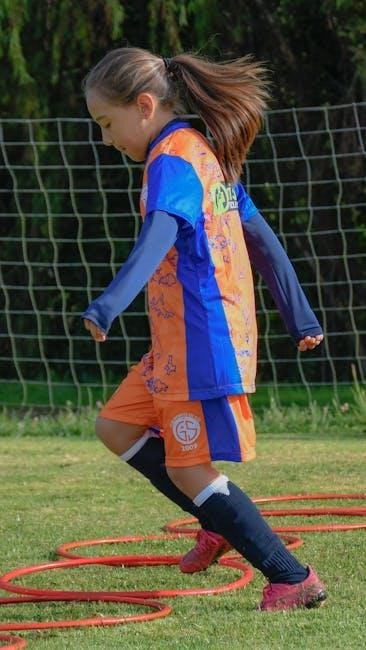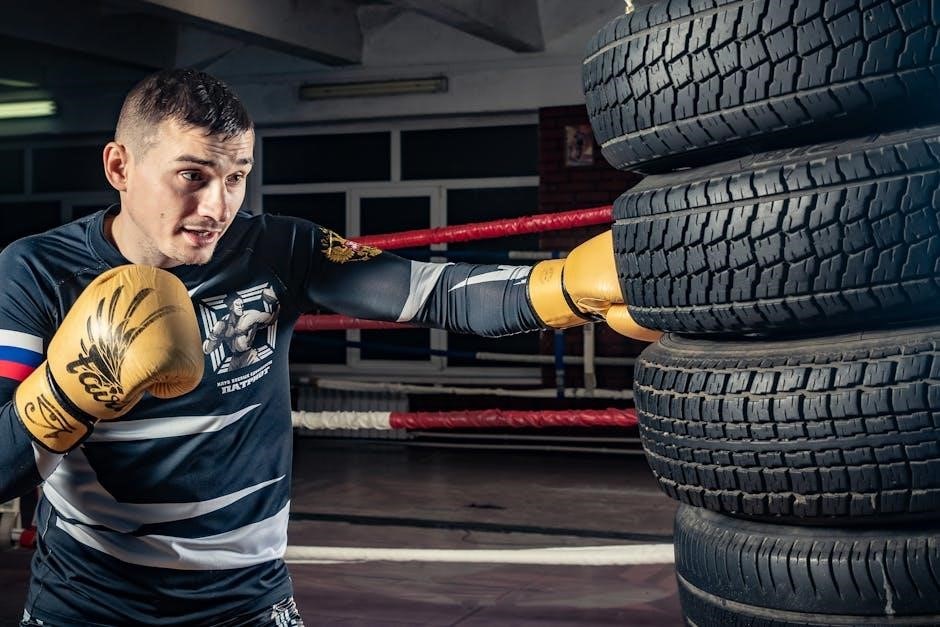Agility Ladder Drills: A Comprehensive Guide
Agility ladder drills are a fantastic method to boost foot speed, coordination, and overall agility. They are integral to SAQ programs, benefitting various sports. This comprehensive guide introduces agility ladder drills, exploring setup, benefits, and a variety of exercises. From basic to advanced techniques, this resource will help improve your athletic performance.
Agility ladder drills are a cornerstone of athletic training, enhancing footwork, speed, control, and coordination. These drills offer a versatile platform for practicing movement patterns applicable across numerous sports. The agility ladder, typically 10 yards long and 20 inches wide, features evenly spaced rungs that create a grid for varied footwork exercises. These exercises improve not only agility but also cognitive functions like reaction time and spatial awareness.
Ladder drills emphasize quality and form over maximal exertion, focusing on precise movements and rhythmic patterns. The drills range from simple in-and-out steps to more complex sequences involving lateral movements, hops, and quick changes of direction. They are scalable for athletes of all levels, from beginners learning basic foot placements to advanced athletes refining their agility for sport-specific applications.
Integrating agility ladder drills into a training regimen can lead to improved overall athleticism and enhanced performance in various physical activities. By engaging in regular ladder training, athletes can develop the agility, speed, and coordination needed to excel in their chosen sports.
Benefits of Agility Ladder Training
Agility ladder training offers a wide range of benefits that extend beyond just improving foot speed. These drills enhance overall agility, coordination, and balance, leading to improved athletic performance in various sports and activities. One of the primary benefits is the development of foot speed and quicker reaction times; By consistently practicing ladder drills, athletes can train their feet to move faster and more efficiently, enabling them to react more quickly to changes in direction.
Agility ladder training also significantly enhances coordination. The precise foot placements required in these drills improve the communication between the brain and muscles, resulting in smoother and more controlled movements. Furthermore, these drills improve balance by challenging athletes to maintain stability while performing rapid movements. This enhanced balance can reduce the risk of falls and injuries.
Beyond physical benefits, agility ladder training improves cognitive functions such as focus and concentration. The mental focus required to execute these drills accurately can translate to improved concentration in other areas of life. Integrating agility ladder training into a fitness routine can lead to significant improvements in overall athletic ability.
Agility Ladder Specifications and Setup
An agility ladder, also known as a speed ladder, is a piece of training equipment designed to enhance footwork, coordination, and agility. A standard agility ladder typically measures around 15 feet in length and 20 inches in width. It consists of flat rungs or slats connected by two parallel straps, forming a series of squares or spaces. The rungs are usually made of durable plastic or nylon, while the straps are often constructed from sturdy nylon webbing to withstand repeated use.
When setting up an agility ladder, it is essential to choose a flat and even surface to prevent tripping hazards. The ladder should be laid out in a straight line with enough space on either side for athletes to move freely. Secure the ladder to the ground using stakes or tape to prevent it from shifting during drills. The spacing between the rungs can be adjusted to increase or decrease the difficulty of the exercises.

Proper setup ensures safety and effectiveness. Whether indoors or outdoors, a stable and well-positioned ladder is crucial for maximizing the benefits of agility training. Taking the time to set up the ladder correctly can significantly enhance the training experience.
Basic Agility Ladder Drills
Basic agility ladder drills are fundamental exercises designed to improve foot speed, coordination, and agility. These drills typically involve simple movement patterns performed within the squares of the ladder. One common drill is the “one foot in each” pattern, where the athlete runs forward, placing one foot in each square. Another variation is the “two feet in each” drill, which involves placing both feet in each square before moving to the next.
The “side shuffle” drill requires athletes to move laterally along the ladder, stepping into each square with one foot and then the other. The “Icky Shuffle” is another popular drill that involves a more complex footwork pattern. Athletes move forward, placing one foot inside the square and the other outside, alternating with each step. These basic drills help develop fundamental movement skills and build a solid foundation for more advanced agility exercises.

Focus should be on maintaining proper form, quick footwork, and a steady rhythm. By mastering these basic drills, athletes can significantly improve their overall agility and coordination.
Intermediate Agility Ladder Drills
Intermediate agility ladder drills build upon the foundational skills developed in the basic drills, introducing more complex movement patterns and increased speed requirements. These drills challenge athletes to improve their coordination, agility, and reaction time further. One such drill is the “in-in-out-out” pattern, where athletes step both feet inside a square, then immediately step both feet outside to the side, repeating this sequence down the ladder.
Another effective intermediate drill is the “lateral in-out,” which involves stepping one foot into the square and then immediately out to the side, followed by the other foot mirroring the movement. This drill enhances lateral agility and foot speed. The “zig-zag” drill requires athletes to step diagonally into each square, alternating directions with each step, improving their ability to change direction quickly.
Proper form and controlled movements are crucial. Athletes should focus on maintaining a low center of gravity and using their arms for balance. These drills increase the demand on the athlete’s cognitive processing and motor control, preparing them for advanced agility exercises used in various sports.
Advanced Agility Ladder Drills
Advanced agility ladder drills are designed to challenge elite athletes, requiring exceptional coordination, speed, and cognitive processing. These drills often incorporate complex footwork patterns, plyometric elements, and rapid decision-making to simulate game-like situations. One example is the “Icky Shuffle,” where athletes alternate leading with each foot, stepping into and out of the ladder squares with a rapid, shuffling motion. This drill dramatically improves foot speed and lateral agility.

Another challenging drill is the “Lateral Shuffle with Crossover,” which combines lateral shuffling with alternating crossover steps inside and outside the ladder. This exercise enhances multi-directional agility and requires precise foot placement. The “Hopscotch” drill involves single-leg hops into and out of the ladder squares, promoting explosive power and balance. Athletes can vary the sequence of hops to increase the difficulty.
These advanced drills demand intense focus and control. Athletes should maintain a low center of gravity, use their arms for balance, and strive for fluid, efficient movements. Proper warm-up and progressive overload are crucial to prevent injuries. Mastery of these drills translates to improved athletic performance in sports requiring rapid changes in direction and quick reactions.
Agility Ladder Drills for Specific Sports
Agility ladder drills can be adapted to enhance performance in various sports by targeting specific movement patterns and skills; For basketball players, drills focusing on lateral movement and quick changes of direction are crucial. The “Lateral Two-In, Two-Out” drill improves foot speed and the ability to guard opponents effectively. “Carioca” variations can enhance hip mobility and lateral agility, essential for navigating the court.
For football players, ladder drills can improve acceleration, deceleration, and agility in tight spaces. The “Rapid Feet” drill, which involves quick, short steps inside each ladder square, enhances foot speed and explosiveness off the line. “In-Out-In” drills can improve cutting ability and agility in congested areas. These drills help players quickly react to changing game situations.
Soccer players can benefit from drills that improve footwork, ball control, and agility with the ball. The “Lateral Shuffle” drill enhances agility and the ability to change direction while maintaining possession. Combining ladder drills with ball-handling exercises, such as dribbling through the ladder squares, can improve coordination and agility with the ball at their feet.
Adapting agility ladder drills to specific sports allows athletes to target the precise skills and movements necessary for optimal performance, leading to improved speed, agility, and coordination on the field or court.
Agility Ladder Drills for Soccer
Agility ladder drills are invaluable for soccer players, enhancing foot speed, coordination, and agility—essential components for excelling on the field. Specific drills can improve a player’s ability to quickly change direction, maintain balance, and control the ball in high-pressure situations.
One fundamental drill is the “Two-Foot In” exercise, where players hop with both feet into each square of the ladder; This improves foot speed and coordination, crucial for quick movements. The “Lateral Shuffle” drill enhances lateral agility, enabling players to swiftly move sideways while maintaining balance, vital for defensive maneuvers and quick transitions.
The “Icky Shuffle” drill focuses on complex footwork patterns, improving agility and the ability to quickly react to changing game situations. Players move laterally, alternating feet in and out of the ladder squares, enhancing coordination and foot speed. Incorporating a soccer ball into these drills further enhances their effectiveness. Dribbling through the ladder squares improves ball control and coordination.
Another effective drill is the “In-Out” pattern, where players step one foot inside and then outside each square, improving agility and quickness. These ladder drills help soccer players develop the agility, foot speed, and coordination needed to outmaneuver opponents and perform at their best.
Agility Ladder Drills for Baseball
Agility ladder drills are beneficial for baseball players, improving foot speed, coordination, and agility—critical for various positions. These drills enhance a player’s ability to quickly react, change direction, and maintain balance, essential for both offensive and defensive plays. By incorporating agility ladder drills into training, baseball players can significantly improve their overall performance and reduce the risk of injuries.
One effective drill for baseball is the “Lateral Shuffle,” where players move sideways along the ladder, placing one foot in each square. This drill enhances lateral quickness, which is vital for infielders reacting to ground balls and outfielders covering ground. The “Icky Shuffle” is another beneficial drill, improving footwork and coordination. Players move laterally, alternating their feet in and out of the ladder squares, enhancing agility.
For base running, the “Quick Feet” drill is essential. Players rapidly step both feet into each square, focusing on speed and precision. This drill enhances foot speed and quickness, crucial for stealing bases and advancing on hits. Incorporating baseball-specific movements into these drills can further enhance their effectiveness.
For example, players can practice fielding ground balls immediately after completing a ladder drill, simulating game situations. These drills provide a foundation for quicker reactions and improved agility on the baseball field.
Common Mistakes and How to Avoid Them
When performing agility ladder drills, several common mistakes can hinder progress and increase the risk of injury. One of the most frequent errors is prioritizing speed over form. Rushing through the drills without maintaining proper technique can lead to sloppy footwork and decreased coordination. To avoid this, focus on accuracy and controlled movements before gradually increasing speed.
Another common mistake is failing to engage the core muscles. A strong core provides stability and balance, essential for executing quick changes in direction. Neglecting core engagement can result in instability and increase the risk of ankle or knee injuries. To correct this, consciously activate your core throughout each drill, maintaining a stable posture.
Insufficient warm-up is another error that can lead to muscle strains and reduced performance. Before starting agility ladder drills, perform dynamic stretches and light cardio to prepare your muscles and joints. A proper warm-up increases blood flow and improves flexibility, reducing the risk of injury. Also, avoid using the wrong ladder. A standard agility ladder is 15 feet long and 20 inches wide.
Finally, improper foot placement can lead to tripping or stumbling. Ensure you are lifting your feet high enough and placing them accurately within each square. Practice drills slowly at first, focusing on precise foot placement, before gradually increasing speed and intensity. Regular practice and attention to detail will help you avoid these common mistakes and maximize the benefits of agility ladder training.
Sample Agility Ladder Workout Routines

To effectively incorporate agility ladder drills into your training, consider these sample workout routines designed for different fitness levels. A beginner routine might focus on fundamental drills to build coordination and foot speed. Start with a five-minute warm-up consisting of light cardio and dynamic stretching. Then, perform each of the following drills for two sets of 30 seconds, with a 30-second rest between sets: the In-In-Out-Out drill, the Lateral Shuffle, and the Forward Run.
An intermediate routine can introduce more complex drills and increase the intensity. After the warm-up, include drills like the Icky Shuffle, the Hopscotch, and the Lateral In-Out drill. Perform three sets of 45 seconds for each drill, with a 45-second rest between sets. Focus on maintaining proper form and controlled movements as you increase speed.
For advanced athletes, a challenging routine can incorporate plyometric elements and high-intensity intervals. Begin with a thorough warm-up, then perform drills such as the Single-Leg Hop, the Carioca, and the Burpee Ladder Drill. Complete four sets of 60 seconds for each drill, with a 30-second rest between sets. Emphasize explosive movements and quick transitions to maximize agility and power.
Remember to cool down with static stretching after each workout to improve flexibility and reduce muscle soreness. Adjust the duration and intensity of these routines based on your individual fitness level and training goals. Consistency is key to seeing improvements in agility and coordination.
Integrating Agility Ladder Drills into Training Programs
Agility ladder drills can be seamlessly integrated into various training programs to enhance footwork, speed, and coordination. These drills are versatile and can be adapted for athletes of all levels and across different sports. To effectively incorporate agility ladder drills, begin by assessing the athlete’s current skill level and identifying specific areas for improvement. Start with basic drills and gradually progress to more complex movements as proficiency increases.
When designing a training program, consider the athlete’s sport-specific needs and goals. For example, soccer players may benefit from drills that improve lateral agility and quick changes of direction, while basketball players may focus on drills that enhance foot speed and reaction time. Agility ladder drills can be incorporated into warm-up routines to prepare the body for more intense training sessions or used as part of a dedicated agility workout.
Frequency and duration are crucial factors to consider. Aim for 2-3 agility ladder sessions per week, with each session lasting between 15-30 minutes. It’s essential to prioritize proper form and technique over speed, especially when introducing new drills. As athletes become more comfortable with the movements, gradually increase the speed and intensity.
Moreover, agility ladder drills can be combined with other training modalities, such as plyometrics and strength training, to create a well-rounded program that promotes overall athletic development. Remember to monitor progress and make adjustments to the training program as needed to ensure continuous improvement.
